
A shrine to the Virgin Mary, or Marian shrine, is a shrine marking an apparition or other miracle ascribed to the Blessed Virgin Mary, or a site on which is centered a historically strong Marian devotion. Such locales are often the destinations of Christian pilgrimages.

Our Lady of China, the Great Mother, also known as Our Lady of Donglü, is a Roman Catholic title of the Blessed Virgin Mary and Child Jesus associated with a purported Marian apparition in Baoding, China in 1900.
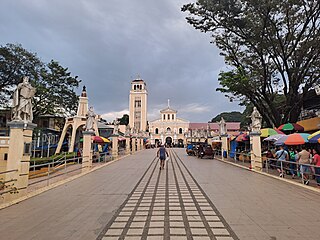
Manaoag, officially the Municipality of Manaoag, is a 1st class municipality in the province of Pangasinan, Philippines. According to the 2020 census, it has a population of 76,045 people.
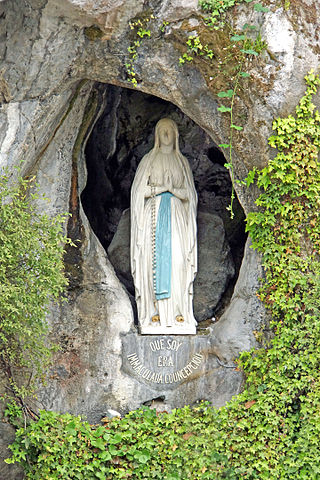
Our Lady of Lourdes is a title of the Virgin Mary. She is venerated under this title by the Roman Catholic Church due to her apparitions that occurred in Lourdes, France. The first apparition of 11 February 1858, of which Bernadette Soubirous told her mother that a "Lady" spoke to her in the cave of Massabielle while she was gathering firewood with her sister and a friend. Similar apparitions of the "Lady" were reported on 18 occasions that year, until the climax revelation in which she introduced herself as: "the Immaculate Conception". On 18 January 1862, the local Bishop of Tarbes Bertrand-Sévère Laurence endorsed the veneration of the Blessed Virgin Mary in Lourdes.

The Sanctuary of Las Lajas is a Catholic minor basilica located within the canyon of the Guáitara River in Ipiales, Nariño Department, Colombia. The Marian shrine is dedicated to the Blessed Virgin Mary as Our Lady of the Rosary.

Our Lady of Manaoag is a Roman Catholic title of the Blessed Virgin Mary venerated in Manaoag, Pangasinan, the Philippines. The sacred statue is referred to as Apo Baket in the native language of local devotees.

Mary, the Help of Christians is a Catholic title of the Blessed Virgin Mary, based on a devotion now associated with a feast day of the General Roman Calendar on 24 May.
Our Lady of Charity is a celebrated Marian title of the Blessed Virgin Mary venerated in many Catholic countries.
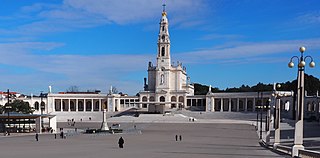
The Sanctuary of Fátima, officially titled Sanctuary of Our Lady of the Rosary of Fátima, is a Marian shrine dedicated to Our Lady of Fatima located in Fátima, in the municipality of Ourém, in Portugal. It consists of a group of Catholic religious buildings and structures with the Basilica of Our Lady of the Rosary as the main building.

The National Shrine of Our Lady of Fatima(Filipino: Pambansang Dambana ng Mahal na Birhen ng Fatima) is a Roman Catholic parish church and national shrine in the Diocese of Malolos in the Philippines. It serves as a Philippine apostolate of Our Lady of Fatima in Fátima, Portugal, which is recognized by the Roman Catholic Church in the Philippines. The shrine is located near the Our Lady of Fatima University campus in Marulas, Valenzuela City in Metro Manila, Philippines. The shrine is one of the three major pilgrimage sites in the Diocese of Malolos, with the National Shrine of St. Anne in Hagonoy and the National Shrine of Divine Mercy in Marilao as the other sites.

Our Lady of Piat is a 16th-century Roman Catholic icon of the Blessed Virgin Mary enshrined in a minor basilca situated in Piat, Cagayan, Philippines. It is the town's and the province's patroness and is one of the most venerated Marian images of Mary in the Philippines, referred to as the "Mother of Cagayan".

Our Lady of Peace and Good Voyage, also known as Our Lady of Antipolo and the Virgin of Antipolo, is a seventeenth-century Roman Catholic wooden image of the Blessed Virgin Mary as venerated in the Philippines. This Black Madonna is enshrined in Antipolo Cathedral in the Sierra Madre mountains east of Metro Manila.

The Basilica Minore of Our Lady of Piat is one of the twenty-one minor basilicas in the Philippines. Located at Poblacion, Piat, in the province of Cagayan, it is the seat of the Roman Catholic Archdiocese of Tuguegarao. The shrine is dubbed as the Pilgrimage Center of Northeast Luzon and is home to the centuries-old brown Madonna Our Lady of Piat.

Our Lady of the Most Holy Rosary – La Naval de Manila is a venerated title of the Blessed Virgin Mary associated with the same image in the Philippines. Pious believers believe that the Virgin's intercession under this title helped to defeat the invading forces of the Protestant Dutch Republic during the Battles of La Naval de Manila in 1646.
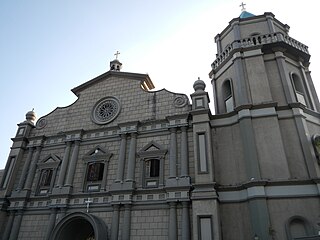
The Minor Basilica of Our Lady of the Most Holy Rosary of Orani, commonly known as Orani Church, is a Roman Catholic minor basilica built in the Neoclassical style located in the center of Orani, Bataan, in the Philippines.
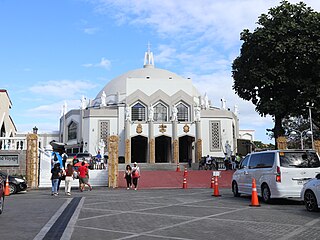
The International Shrine of Our Lady of Peace and Good Voyage, popularly known as the Antipolo Cathedral and alternatively as the Immaculate Conception Parish, is a Roman Catholic cathedral in Antipolo, Philippines. It enshrines a venerated Black Madonna image of the Blessed Virgin Mary under the title of Our Lady of Peace and Good Voyage, and serves as the seat of the Bishop of Antipolo.

Our Lady of Consolation or Mary, Comforter of the Afflicted is a title of the Blessed Virgin Mary venerated in the Catholic Church.

Basilicas are Catholic church buildings that have a designation, conferring special privileges, given by the Pope. Basilicas are distinguished for ceremonial purposes from other churches. The building need not be a basilica in the architectural sense. Basilicas are either major basilicas, of which there are four, all in the Diocese of Rome, or minor basilicas, of which there were 1,810 worldwide as of 2019.

Urdaneta Cathedral, formally referred to as the Our Lady of the Immaculate Conception Cathedral Parish, is a cathedral of the Roman Catholic Church located in the city of Urdaneta, Pangasinan in the Ilocos Region of the Philippines. Situated at Barangay Poblacion of Urdaneta, it is the seat of the Roman Catholic Diocese of Urdaneta and is dedicated to Mary under the title of Our Lady of the Immaculate Conception.

Mount Carmel Shrine, also known as Minor Basilica of the National Shrine of Our Lady of Mount Carmel, , is a Roman Catholic minor basilica and national shrine located in Barangay Mariana, Quezon City, Metro Manila in the Philippines. Dedicated to Our Lady of Mount Carmel, the church opened in 1964 after a decade of construction. It was declared a parish church in 1975 and a national shrine in 2015. In 2019, it was declared a minor basilica, making it the fifteenth minor basilica in the country.





























